
* Along with EOGBs, the US war in Vietnam saw the introduction of "laser-guided bombs", which proved highly effective, and would become standard weapons after the war. Two other guided munitions that entered the US arsenal were developed roughly in parallel, including the "Maverick" air-to-surface missile and the "Penguin" antiship missile.
* The invention of the laser in the early 1960s led immediately to excited visions of "death rays" that could shoot down enemy missiles, but such "directed energy" weapons proved a major challenge, and are only now beginning to seem practical. The laser did, however, have significant short-term potential for use in combat.
Using a laser as a weapon itself places enormous demands on device physics and energy supply, but the fact that a laser beam can be precisely pointed and remains tightly organized ("coherent" in laser terminology) over long range meant that it could be used as a precise pointing device. A laser could be strapped to a telescopic camera with crosshairs so that the beam could be focused to "illuminate" a particular target to "mark" or "designate" it. The fact that a laser also generates a narrow range of colors ("monochromatic") also meant that the light reflected off such a target could be easily detected by simple sensors through a filter lens. A guided weapon could be fitted with such a sensor, with the sensor linked to feedback-control mechanisms so that it would home in on an illuminated target.
The idea of using a laser to designate targets apparently was devised in 1960 by two civilian engineers, David J. Salonimer and Norman Bell, at the US Army Missile Command in Huntsville, Alabama. The two were interested in building laser-guided artillery shells, and conducted studies on laser designator and seeker systems. Salonimer managed to get a little funding, and worked with Weldon Word of Texas Instruments (TI) to modify a Shrike anti-radar missile -- a variant of the Sparrow air-to-air missile -- as a laser-guided surface-to-surface weapon. The experiment didn't work out, but the idea of laser-guided weapons didn't go away.
Inspired by the Shrike experiment, Martin Marietta performed experiments of their own with laser targeting systems, and in 1964 demonstrated such a device to the Air Force, leading to a modest contract to TI the next year for an experimental demonstration of a "laser-guided bomb (LGB)". TI engineers built the first semi-active laser seeker, based on an airflow test probe fitted to the nose of a bomb on a universal joint. The unit looked like a badminton "birdie", and so was called a "birdie head". It controlled the movement of four fins, which were originally fitted to the tail of the guided bomb.
The seeker had an optical sensor, shielded by a filter lens that was transparent to laser light but blocked light of other wavelengths. The sensor was a simple array of photodiodes, arranged in quadrants. The quadrant that picked up the most light energy activated the fins, which were operated in a "bang-bang" control mode: they were either deflected completely to one or the other limits of their range of movement, or remained straight. The fins operated in pairs arranged symmetrically around the guided bomb to shift the weapon up and down, or left and right.
Early tests were conducted with M117 340-kilogram (750-pound) bombs with moveable tailfins, resulting in the TI "BOLT-117", the first LGB, which was tested in April 1965. It was an awkward improvisation and results were poor, but much improved accuracy was obtained with the use of the more aerodynamic Mark 84 "slick" bomb, with the control fins attached to the nose of the weapon, instead of the tail.
The TI group, working on a shoestring budget with the USAF Armament Development & Test Center at Eglin, conducted tests through the rest of 1965 and 1966. After some work, the bombs became very accurate -- though due to the bang-bang control scheme, the bombs did have a tendency to bob up and down along the laser beam until they locked on target. Despite the lack of a gyrostabilization system, the bombs generally locked on solid after a few seconds.
TI was finally awarded a contract for 50 "Paveway" guidance kits, where "Paveway" is sometimes said to be derived from the "Precision Avionics Vectoring Equipment (PAVE)" -- though it seems more likely that the name was arbitrary, and the acronym invented after the fact. Prototype LGBs were sent to Vietnam in 1968 for operational testing, with mixed results. F-4 Phantom fighter-bombers were used in the tests, with the "weapons system officer (WSO)" in the back seat marking a target with a hand-held laser system designated the "Airborne Laser Designator (ALD)". It proved very difficult to keep the laser aligned on the target, but half the LGBs hit the target anyway.
* The tests led to the "Paveway I" munitions. They consisted of a kit that was attached to Mark 82, Mark 83 and Mark 84 bombs -- at the time, the Mark 81 was seen as too light to be worth making a kit for. LGBs based on the Mark 82 were designated as the "GBU-12/B" series, while those based on the Mark 83 were the "GBU-16/B" series, and those based on the Mark 84 were the "GBU-10/B" series. Each series had variants, such as "GBU-10A/B", "GBU-10B/B", "GBU-10C/B", and so on, that distinction being ignored here for the sake of simplicity.
The guidance kit included a SAL seeker head with four control fins in a cruciform arrangement, which was attached to the front of the bomb, and a tail assembly with four larger fins, also in a cruciform arrangement, which was attached to the rear of the bomb to provide limited glide capability. All the LGBs used the same seeker head, but had different fin assemblies to accommodate different types of bombs.
The LGBs had their own power supply, consisting of a thermal battery for the electronics, along with a hot gas-driven actuator to move the seeker head. They did not require any electrical connection to the aircraft. They could be launched by any aircraft that could carry ordinary bombs of the same size, and could be guided by a laser designator on the launch aircraft; on a spotter aircraft; or operated by ground forces. The Air Force developed a laser designator for the F-4 under the code name "Pave Knife". This consisted of a laser slaved to a TV camera, and allowed the Phantom back-seater to spot a target while the pilot concerned himself with evasive action.
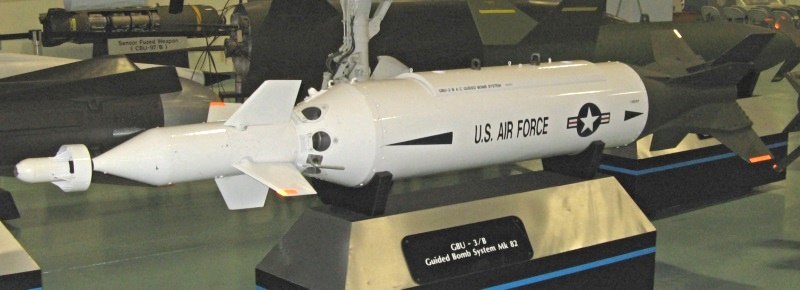
A kit was also developed for an SUU-51/B cluster munition canister, resulting in the "GBU-3/B", but it wasn't fielded; precision guidance for a cluster bomb carrier was not seen as needed. In any case, the LGB kits only cost a few thousand dollars US, and were produced in great quantity. Tens of thousands of them were used in Vietnam, proving themselves in the North Vietnamese ground offensive into South Vietnam in the spring of 1972, and the LINEBACKER bombing campaign late in that year. Lightweight Paveways scored direct hits on North Vietnamese tanks, while heavyweight Paveways destroyed bridges that had survived repeated conventional bombing raids.
* The initial Paveway design gave way to an improved series, known as "Paveway II", in the early 1970s. These weapons featured an enhanced -- as well as simpler and cheaper -- seeker head, plus distinctive pop-out wings for the rear assembly to improve the weapon's glide characteristics, and make it easier to fit to aircraft. They retained the designations of the Paveway I munitions -- GBU-12/B, GBU-16/B, and GBU-10/B -- with new variant codes.
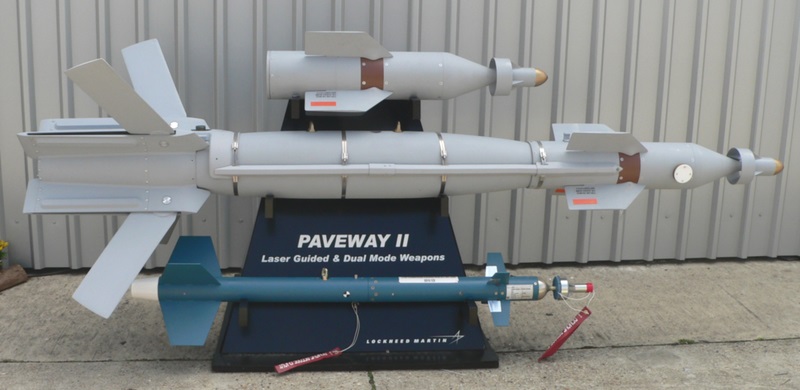
The British RAF also adopted a Paveway II variant known as the "Mark 13/18", based on a British 450-kilogram (1,000-pound) GP bomb, this munition being used by Harrier strike aircraft during the Falklands War in 1983. GBU-10C/B heavyweight bombs were used by F-111 strike aircraft in the 1986 EL DORADO CANYON punitive raid on Libya.
The US Navy wanted to increase the range of their Paveway II weapons, and so devised a variant fitted with the solid rocket motor from a Shrike missile. This weapon was based on the Mark 83 bomb and is known as the "AGM-123 Skipper II". A Skipper II was used in 1988 during the Persian Gulf convoy operations to sink an Iranian frigate.
* The Paveway II required the launch aircraft to operate from medium altitude so that the bomb would have a direct path to the target. That left the aircraft vulnerable to ground defenses, and so in 1976 the USAF issued a requirement for another generation of Paveway weapons, the "Paveway III".
The Paveway III used larger rear fins and a "smart" seeker head that incorporated a microprocessor-based digital autopilot, coupled to a more sensitive seeker with a wider field of view. Unlike earlier Paveway seekers, the seeker head on the Paveway III did not pivot, and the weapon did not use "bang-bang" control -- instead following as efficient a path to the target as possible. Bang-bang control was simple, but wasted much of the bomb's kinetic energy and reduced its range. A Paveway III bomb, in contrast, could be released at low altitude and then sail almost level into the target area, where it would then dive directly into a target.
The USAF only fielded the heavyweight Mark 84 / BLU-109 penetrator versions, with test and evaluation completed in 1986; these munitions were designated as the "GBU-24/B" series. For whatever reasons, the lightweight and middleweight LGBs continued to be designated as Paveway II weapons -- though they were refined and upgraded, so eventually they obtained Paveway III technology.
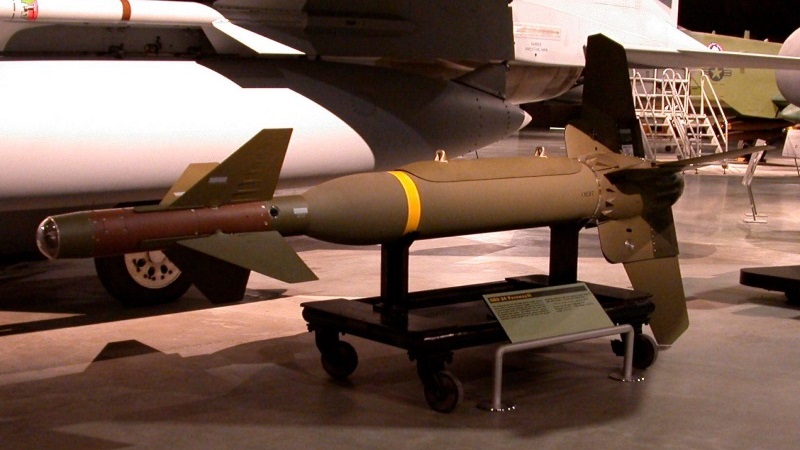
An improved Paveway III kit was used with the F-117 Stealth fighter, with the munition being designated the "GBU-27/B". The USAF worked on an "Advanced Unitary Penetrator (AUP)" munition externally similar to the BLU-1 that could achieve twice the depth of penetration by the interesting method of shedding its outer layers, but it was not adopted for service.
Confronted with deeply-buried Iraqi command bunkers in the First Gulf War, the USAF found that even Paveway IIIs built around the hardened BLU-109 bomb didn't do the job, and a crash program was put in motion to build something more fearsome. The new "bunker-busting" bomb, the "GBU-28/B", was prototyped in 17 days, using scrapped 203-millimeter (8-inch) artillery barrels with Paveway III kits attached.
A single test drop was performed at the Tonopah Test Range in Utah, with the bomb burying itself so deep that it could not be reasonably recovered. More GBU-28/Bs were quickly built, airlifted to the Gulf, and immediately used to attack hardened Iraqi installations. Each GBU-28/B weighed 2,250 kilograms (5,000 pounds). It consisted of a guidance kit attached to a BLU-113/B 2.1-tonne (4,700-pound) penetrator bomb.
The GBU-28/B was also used in the American war in Afghanistan in the winter of 2001:2002, carried by B-52s and F-15Es. Only a limited batch was built in the first place, and stocks ran low during the campaign. The Air Force went on to obtain a batch of improved GBU-28/B bombs, based on the new BLU-122/B penetrating bomb -- at 2.02 tonnes (4,450 pounds), slightly lighter than the BLU-113/B, but more effective.
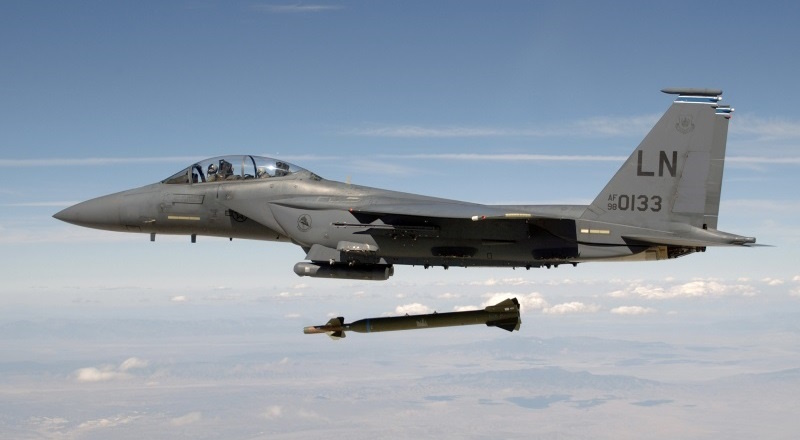
Some 9,000 Paveway II and III munitions were dropped during the First Gulf War. Video recordings taken by targeting systems showed Paveways and other smart munitions dropping into the front doors of aircraft shelters and falling into the ventilation shafts of buildings, blowing them apart with satisfying effect. These proved a striking and impressive propaganda tool for US forces. Videos that showed the gruesome effects of high explosive blasts on humans were, understandably but a little dishonestly, not released to the public. One Paveway was even used to blast an Iraqi helicopter out of the sky, an action-movie stunt that probably amused one side of the transaction immensely.
During the Anglo-American invasion of Iraq in the spring of 2003, US forces used lightweight LGBs filled with concrete as "minimum collateral damage" munitions to perform precision attacks on targets in built-up urban areas. These weapons were designated "GBU-45/B". The British also used practice LGBs filled with concrete during the campaign. The idea of turning an LGB into a "smart rock" was dreamt up by the Israelis during their squabbles with the Palestinians. The Americans later fielded a "Low Collateral Damage Bomb", which was a core munition with a composite case and modified explosive filler to reduce damage outside the immediate impact area, allowing the weapon to be used in built-up areas.
Hundreds of thousands of Paveway LGBs were produced, and tens of thousands used in combat. Upgrade kits were introduced in the late 1990s to add GPS-INS guidance to LGBs, these being referred to as "dual-mode" munitions. They were originally designated "EGBU", for "Enhanced Glide Bomb Unit" -- this usage was dropped, with the GPS-INS guidance being designated by an "E" variant code, for example "GBU-24E/B".
The end result of such upgrades was a bit of designation confusion, with Lockheed Martin selling GPS-INS-enhanced LGBs as "Paveway II Plus", leading to a refined "Dual Mode Plus" munition, which the company introduced as "Paragon". Raytheon also sold a dual-mode munition as the "Paveway IV", based on Paveway III technology and featuring a "smart" fuzing system that allows the pilot to select airburst, burst on impact, or post-impact time-delay burst before weapon drop. Paveway IV was obtained by the RAF and the Royal Saudi Air Force, but not the US military -- which has shifted to the JDAM series of munitions, discussed later.
Paveway munitions remain in inventory, but don't appear to still be in production. As a footnote, Lockheed Martin produced an LGB "training round", the "laser-guided training round (LGTR)", which the company introduced into production in 1992, with an "enhanced LGTR (ELGTR)" introduced in 2006. It weighed about 40 kilograms (88 pounds), but handled like a full-size LGB. It was only armed with a small "spotting charge" -- but Lockheed Martin promoted the ELGTR with a more potent charge as a low-collateral-damage munition for piloted aircraft and drones, under the name of "Scalpel", with an improved "Scalpel Plus", with added GPS-INS guidance later offered. It doesn't appear anyone was interested.
BACK_TO_TOP* As a footnote before proceeding, development of LGBs was shadowed by the development of laser designators and targeting pods. A typical targeting pod features a motion-stabilized turret in the nose containing a camera boresighted with a laser system that illuminates a target, with the laser system also providing rangefinder capabilities. The camera may be a daylight or low-light-level TV (LLLTV) camera; or a forward-looking infrared (FLIR) imager; or both may be included, defining an "electro-optic / infrared (EO-IR)" sensing system. EO-IR is the norm in current days. The camera or cameras will have multiple levels of zoom to provide either a wide field of view or a close-up on a target.
The pod is typically carried by a two-seat strike aircraft, with the weapons system officer (WSO) in the back seat viewing the target image provided by the pod, and using a joystick or similar hand controller to keep the target lined up in the display crosshairs. The latest pods will have "smart" features, such as target recognition or automatic target tracking. Western laser designators use a NATO-standardized pulse-code scheme to allow multiple LGBs to be dropped simultaneously during an engagement, without confusion.
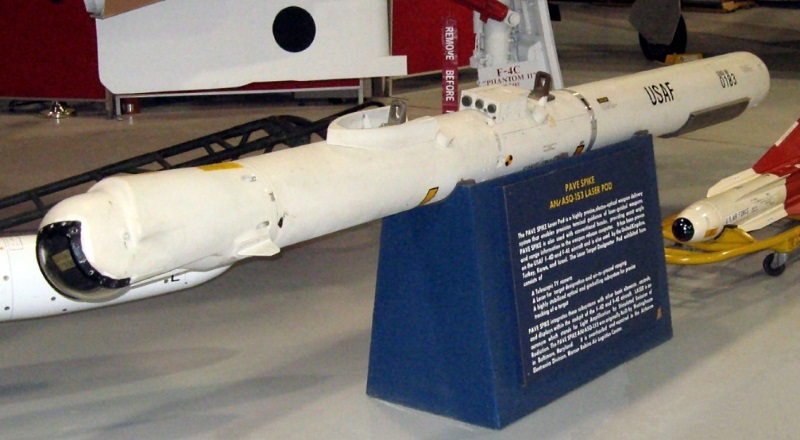
As mentioned earlier, the USAF used the ALD targeting system early on, later fielding the Pave Knife pod. It left something to be desired, and was quickly followed by better technology:
The early targeting pods were followed by still better systems, most significantly the Martin-Marietta (now Lockheed Martin) "Low Altitude Navigation and Targeting, Infrared, for Night (LANTIRN)". LANTIRN actually includes a pair of pods:
LANTIRN was carried by USAF F-15s and F-16s, and has been manufactured in improved variants. At last notice, the LANTIRN navigation pod was still in service, but the targeting pod had been replaced by the Lockheed Martin's "AN/AAQ-33 Sniper" targeting pod, itself available in a series of refined variants.
The US Navy has fielded their own series of targeting pods, the Lockheed "AN/AAS-38 Nite Hawk" pod having been followed by the improved Raytheon "AN/ASQ-228 Advanced Targeting FLIR (ATFLIR)" pod. The USAF, Navy, and Marines also adopted the Northrop Grumman "AN/AAQ-8 Litening" pod, which was actually designed by Rafael of Israel.
Some aircraft built specifically for the strike role may actually have a built-in targeting system, eliminating the need to carry a pod. As a prominent example, from the late 1970s the US Navy's Grumman A-6E Intruder strike aircraft were fitted with an undernose turret with a FLIR and laser designator / rangefinder, designated the "AN/AAS-33 Target Recognition and Attack Multisensor (TRAM)". The more recent Lockheed Martin F-35 strike fighter also has a built-in "Electro-Optical Targeting System".

Helicopters and light attack aircraft often carry sensor turrets, with EO-IR imaging featuring zoom and image stabilization, with Wescam being the best-known maker of such turrets, offering them in a range of sizes and capabilities. High-end military turrets generally have a laser designator / rangefinder. Laser rangefinders / designators are also often fitted to ground combat vehicles, with sensor turrets becoming more common, generally mounted on an extending mast.
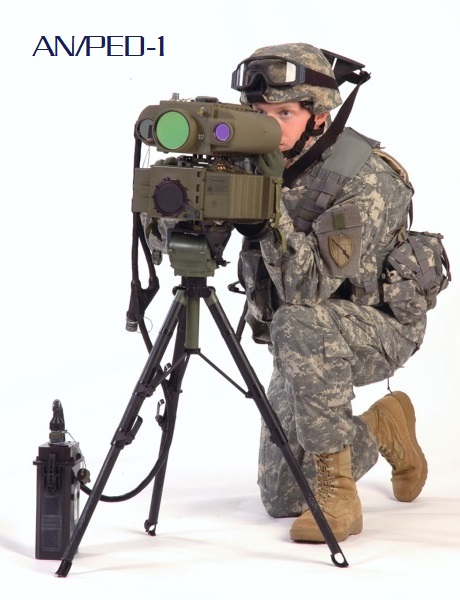
Of course, laser target designators can be carried by ground forces. US Army troops use the Northrop Grumman "AN/PED-1 Lightweight Laser Designator Rangefinder (LLDR)", which is an infantry-portable unit, mounted on a tripod. It features a day camera and an infrared imager; a laser designator and rangefinder; a laser "spot tracker" to spot another laser beam; a GPS and digital magnetic compass locator system; and a digital output port to allow image and target data to be passed on to other systems.
BACK_TO_TOP* The push towards LGBs was paralleled by development of a better air-to-surface missile than the Bullpup. Even before the beginning of major American involvement in Vietnam, the Air Force had worked on an "Anti-Tank Guided Aircraft Rocket (ATGAR)" awarding a contract for the development of the "XAGM-64A Hornet" in 1963. The Hornet was a small solid-fuel rocket with large cruciform tailfins and an EO seeker like that of the Walleye and HOBOS. Test firings of the weapon began in late 1964, but the Air Force quickly gave up on the Hornet due to changing requirements, though a few of them would be used into the early 1970s as testbeds for various new seeker concepts. In 1965, the USAF issue a request for a missile that would meet the new requirements, issuing preliminary investigation contracts in 1966 to North American Rockwell and Hughes.
In 1968, Hughes was awarded the full development contract for the missile, which was named the "Maverick". Unguided launches began in September 1969, and in December 1969 the first guided flight of the weapon scored a direct hit on a tank. An initial production contract for 2,000 missiles was awarded in July 1971, and the Maverick entered service with the USAF at the end of 1972.
The configuration of the initial production "AGM-65A" Maverick set a baseline for later variants. The AGM-65A was a blunt-nosed missile with long narrow cruciform delta wings set towards the rear, followed by four tail fins. It looked something like a fat Falcon air-to-air missile, and in fact the airframe design was based on that of the Falcon. Hughes had apparently experimented with an ASM version of the Falcon, the "AGM-76", about the same time that the company began investigations on Maverick, possibly in hopes of meeting the Air Force requirement with minimal effort, but something better optimized for the task proved desireable.
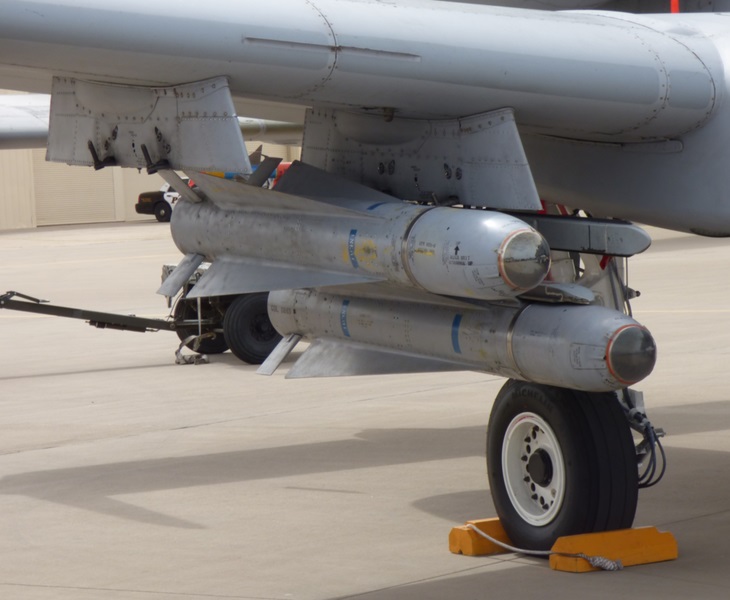
The AGM-65A had a boost-sustain solid fuel rocket motor, and a hollow-charge anti-armor warhead. The weapon has been used by almost all US and many other Western attack aircraft. Up to six could be carried at one time, using a specialized rack to carry three Mavericks on one stores pylon. A single-missile rack was also available for smaller aircraft.
___________________________________________________________________
AGM-65A MAVERICK:
___________________________________________________________________
wingspan:
72 centimeters (2 feet 4 inches)
length:
2.49 meters (8 feet 2 inches)
diameter:
30.5 centimeters (1 foot)
total weight:
210 kilograms (463 pounds)
warhead weight:
59 kilograms (130 pounds)
speed:
supersonic
range at altitude:
23 kilometers (14 MI / 12 NMI)
___________________________________________________________________
The AGM-65A was TV-guided. The operator selected a missile for launch and set the missile's stabilization gyro into operation. When the gyro spun up, an indicator lit up on the cockpit display. When the operator wanted to engage a target, he or she pressed a switch to blow a plastic nose cover off the missile, activating the missile's TV imager, and uncaging the gyro. The aircraft was flown toward the target to get it in the imager's line of sight, with the operator viewing it on a display. The operator lined up crosshairs on a high-contrast element in the target and, when a lock was established, launched the missile.
In early aircraft fitted for Maverick, the image was spliced into the existing radarscope display, though later multifunction displays would become normal equipment. The missile then went on to target without further operator intervention, allowing the launch aircraft to take evasive action against enemy defenses or line up another target.
Thirty AGM-65As were fired in combat tests during the LINEBACKER II air campaign against North Vietnam in 1972. The weapon was hastily supplied to Israel the next year during the Yom Kippur War, through the emergency NICKEL GRASS resupply effort. The Israeli Air Force was enthusiastic about the new weapon and achieved a kill rate of greater than 82%, even though Israeli pilots had no more than the quickest familiarization with the Maverick before flying off to use it on Arab tanks.
* The problem with the AGM-65A was that it was a fair-weather daylight weapon. It worked well in the dry and sunny climates of the Middle East, but there were serious questions of how well it would perform in the damper and darker climate of Northern Europe.
Another limitation of the AGM-65A was that its seeker had a 5 degree field of view, and if the target was small that meant that the launch aircraft had to get uncomfortably close before the seeker locked on. Hughes went back to the drawing board and in 1975 introduced the "AGM-65B" Maverick, which looked externally identical to the AGM-65A, but had a seeker with a 2.5 degree field of view. The narrower field of view doubled the angular size of the image picked up the seeker, and allowed a lock at longer ranges and under poorer visibility conditions. The AGM-65B was sometimes referred to as the "Scene Magnification Maverick".
Hughes followed up this feature with an improvement known as "Quick Draw". Quick Draw allowed one Maverick to be locked onto a target and launched, with the next available missile automatically boresighted onto the same target. This meant that if there were several targets close together, the operator could quickly and accurately launch several missiles in quick succession with only minor movements of the crosshairs, allowing multiple attacks in a single attack pass.
* The AGM-65B was an improvement, but it was still not an all-weather round-the-clock weapon, and other alternatives were investigated. The first option was to use an infrared imager to allow day-night operation and a greater degree of independence from weather. Development of the new seeker was somewhat troublesome, but the bugs were worked out and the first production "AGM-65D" Mavericks with imaging infrared seekers were shipped to the USAF in 1983.
The AGM-65D used a spinning-mirror scanning infrared imager, and allowed the operator to switch between a positive or negative infrared image, since under some conditions a hot-on-cool image would be prominent, while in others the reverse would be true. Skilled operators could use the infrared imager to pick out real targets from decoys, or distinguish between full fuel-storage tanks and empty ones. One operator described the seeker as "Marvel comic X-ray specs".
A minor hardware and software update for the AGM-65D was hastily introduced into service during the 1999 NATO Kosovo campaign. The update improved accuracy, and the modified weapons were designated "AGM-65D2".
* The US Navy obtained a version of the Maverick, designated the "AGM-65F", with an infrared seeker that was optimized to home in on naval vessels. To improve the weapon's destructiveness on naval targets, it was fitted with a 136-kilogram (300-pound) steel-jacketed penetrating warhead. That raised the weight of the missile to 301 kilograms (670 pounds).
The Air Force liked the big warhead idea, and so acquired the "AGM-85G", with an imaging seeker similar to that of the AGM-65D but with some software improvements, and the big warhead used on the AGM-65E/F.
In the meantime, work was done on laser-guided versions of the Maverick. A laser-guided "AGM-65C" was developed in the late 1970s, with the old small shaped-charge warhead, but this version did not go into production. However, a Maverick with a laser seeker and the bigger penetrating warhead, the "AGM-65E", did go into production, with the US Marine Corps as the primary user, though the Navy has used it as well. A laser seeker fit Marine needs better than an imager, since ground troops could pinpoint targets on the battleground with laser designators to allow precision strikes with less chance of "fratricide".
An "AGM-65E2" with an improved seeker and software was later introduced, missiles being obtained both from new production and upgrades of AGM-65A/B missiles. The Air Force obtained a similar laser-guided variant as the "AGM-65L". Work was done to develop a Maverick with a millimeter-wave radar imaging seeker head. A Maverick with such a seeker was tested in 1991, but not put into production.
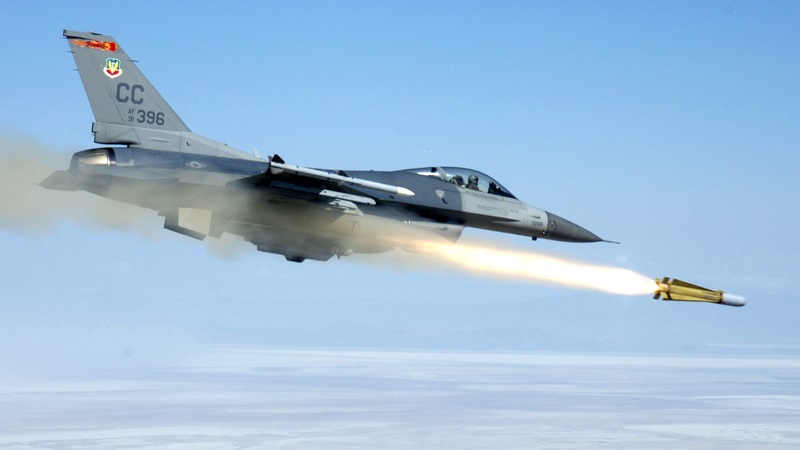
Total production of all variants of the Maverick was in the tens of thousands, and the missile is used by the air forces of over 30 nations. It had been used in small quantities in combat up until the Gulf War in 1991, but it was one of the main smart munitions used in the war against Iraq, with some 5,300 expended. 90% of these were fired by USAF A-10 "Warthog" tank-buster aircraft, which carried a mix of TV and imaging infrared Mavericks. The Mavericks helped destroy thousands of Iraqi tanks, artillery pieces, and vehicles.
The TV and imaging infrared seekers used on the Maverick were fitted to other precision-guided munitions. The 2.5-degree FOV TV seeker was designated the "DSU-27/B", and featured a clear lens; the imaging infrared seeker was designated as the "WGU-10/B". These seekers were used with the GBU-15(V) glide bomb and the AGM-84 SLAM cruise missile. In 1998, the USAF came to an agreement with Maverick second-source Raytheon to upgrade 1,200 older AGM-65Gs with a new imaging seeker, based on a charge-coupled device (CCD) array. The improved Maverick variant, designated "AGM-65K", was more reliable and was able to operate in lower light levels with its more sensitive seeker.
The following list summarizes the different Maverick variants, with the user in parentheses:
* Raytheon also evaluated a Maverick with a GPS-INS guidance system and a datalink to give the missile a "lock on after launch (LOAL)" capability, with the missile flying to the target area from standoff range, and then locked on a target by an operator using the datalink. Even if a lock couldn't be acquired, the GPS-INS system would still get the missile close enough to cause damage to soft targets.
The GPS-INS system would be installed on the nose of the missile, while the datalink system would be installed on the tail. The datalink would allow simultaneous control of several missiles; would allow one aircraft to launch the missile and another to control it; and would also be used to self-destruct the missile if the operator, for example, found the missile had been fired at friendly forces by mistake. The GPS-INS guidance system would have the capacity to store eight sets of target coordinates, along with flight profiles, attack angle, and fuze settings for each target. The guidance system could also be programmed to define "zones of exclusion" that are off-limits to the missile. The navigation system could be programmed on the ground before flight or programmed in flight.
The Maverick rocket motor would be given more fuel to increase standoff distance, and the missile's thermal battery would be improved to provide about three minutes of lifetime to ensure that the missile remained powered in flight. The aircraft display would also be updated to provide such data as remaining time of flight.
The USAF awarded Raytheon an evaluation contract to test the LOAL Maverick, but the exercise went quiet after that. Raytheon also worked on a rebuild of AGM-65F IR seeker / big warhead Mavericks with a low-cost laser seeker, as well as an "extended-range" version of the Maverick with a small turbojet engine that would be fired from helicopters. However, Maverick is now obsolescent; it remains in inventory, but it is being replaced with the "AGM-179 Joint Air-To-Ground Missile (JAGM)", a follow-on to the AGM-114 Hellfire anti-armor missile, with JAGM going into production in 2022.
* As a footnote to Maverick, in the early 1980s, the US military initiated an effort under the general designation of "Assault Breaker" to develop a wide range of next-generation smart weapons. While the Assault Breaker program did lead to some weapons programs that would be fielded, such as the "SFW" submunition discussed later, much of it fizzled out. One of the fizzles was an advanced anti-armor weapon designated "Wasp", apparently with a certain degree of reference to the earlier Hornet missile. Hughes was awarded a contract for the Wasp in 1982.
The Wasp resembled a Maverick in general appearance, except for having a proportionately much longer nose ahead of the wings. The Wasp was also much smaller, with a length of about 1.5 meters (5 feet) and a weight of about 48 kilograms (105 pounds), less than a quarter of the weight of a Maverick.
Wasp was to be tube-launched from a six-tube dispenser, with two missiles per tube. A blast deflection system would protect the rear missile from the exhaust of the front missile. The missiles of course had folding fins. The Wasp was to have a "smart" millimeter-wave seeker that would be able to identify and attack targets on its own after launch. Since such a capability is at the limits of what can be done now, decades later, it appears Wasp was too advanced for the time, and it is unclear if the missile was even test-fired before the program was canceled.
BACK_TO_TOP* Norway and the USA have a close defense relationship, and have collaborated on weapons development. The Norwegians realized in the 1950s that they could not afford a large naval force to defend their coastline, and so emphasized the development of fast, well-armed patrol boats as a low-cost equalizer. The emphasis on patrol boats led to a need for a smart antiship missile to give them an effective weapon. In 1962, the Norwegian government authorized initial studies of a missile that would become known as the "Penguin", with the US Navy providing financial assistance for the demonstration phase of the program. The prime contractor was Kongsberg Vaapenfabrik of Norway.
The US Navy also provided test facilities for Penguin development from 1963 through 1965. The tests were highly successful, and go-ahead was given for full-scale development. In addition, the West German government provided financial assistance during the full-scale development phase, in exchange for access to the technology.
The Penguin "Mark 1" reached full operational status with Norwegian frigates and patrol boats in 1972, and was also sold to Turkey. The Mark 1 was followed in the late 1970s by the "Mark 2", which was developed in cooperation with Sweden. The Mark 2 offered longer range and an improved guidance system. The Penguin Mark 1 and Mark 2 were fired from fixed canisters on board the launch vessel.
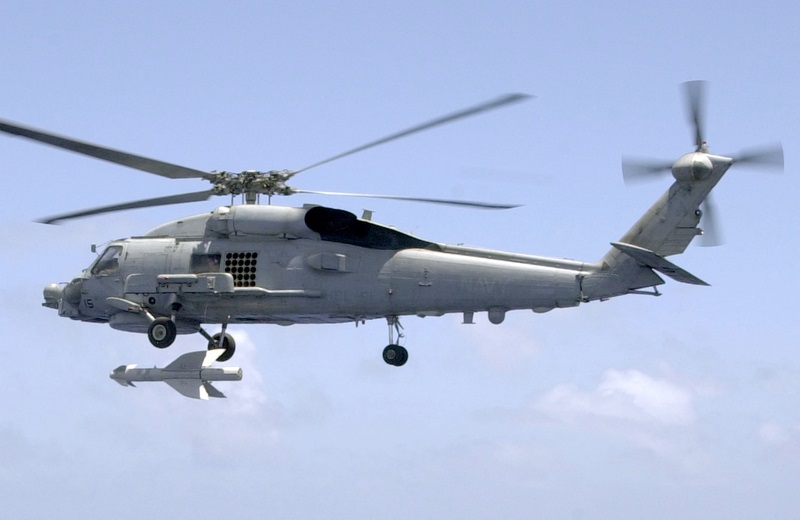
The success of the ship-launched Penguin led to a variant that could also be launched by helicopter, leading up to the "Mark 2 Mod 7", as well as a "Mark 3" version for launch by fixed-wing aircraft. The Penguin Mark 2 Mod 7 was a relatively small antiship missile with a distinctive and unusual canard configuration. It featured folding curved cruciform rear wings and small cruciform control fins around the nose. It was propelled by a boost-sustain solid fuel rocket motor and had a semi-armor piercing (SAP) warhead.
___________________________________________________________________
PENGUIN MARK 2 MOD 7:
___________________________________________________________________
wingspan:
1.4 meters (4 feet 7 inches)
length:
3.1 meters (10 feet)
total weight:
385 kilograms (847 pounds)
warhead weight:
120 kilograms (265 pounds)
speed:
high subsonic
range at altitude:
27 kilometers (17 MI / 15 NMI)
___________________________________________________________________
The Mark 2 Mod 7 had a sophisticated digital guidance system. After launch, it proceeded to the target area under direction of an INS. It could take an oblique path to the target, turning up to 180 degrees around a waypoint, and also can perform random weaves. Terminal guidance was provided by a passive infrared seeker, instead of an active radar seeker as is typical for antiship missiles. When the Penguin was developed, the design team was uncertain that an active radar seeker could be designed that could fit into the relatively small missile. In terminal attack, the Penguin could either strike the target at the waterline, or pop up and dive into it.
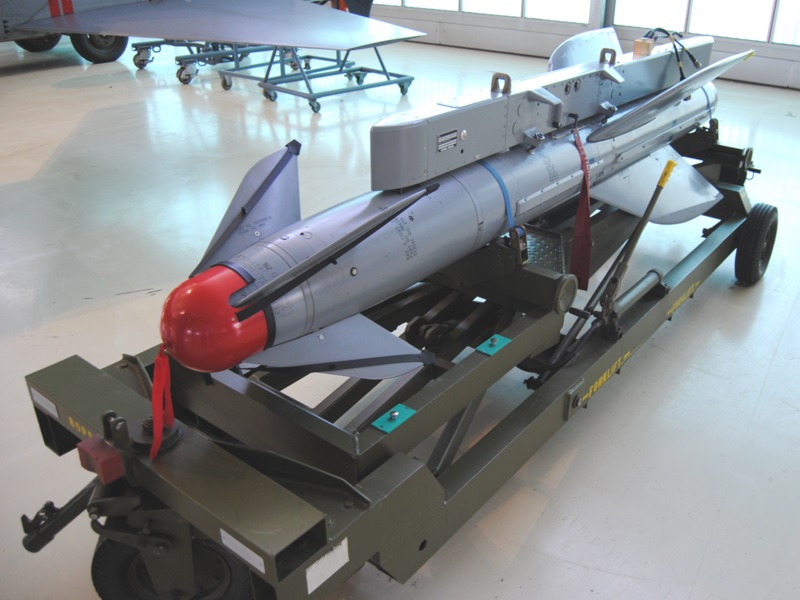
The Penguin was obtained by the US Navy as the "AGM-119", with the Mark 2 Mod 7 being the "AGM-119B". It was deployed with the USN's Seahawk helicopters, and was similarly adopted for helicopter use by the Australian, Brazilian, Greek, Norwegian, and Turkish navies.
The Mark 3 was similar to the Mark 2, but had fixed wings; it was carried by Norwegian Air Force F-16 fighters, with air launch giving it incrementally longer range than the ship-launched variants. Penguins have received updates in service, and there is no talk of a replacement.
BACK_TO_TOP